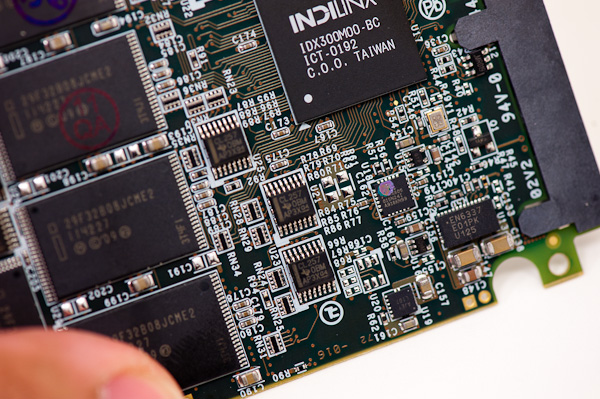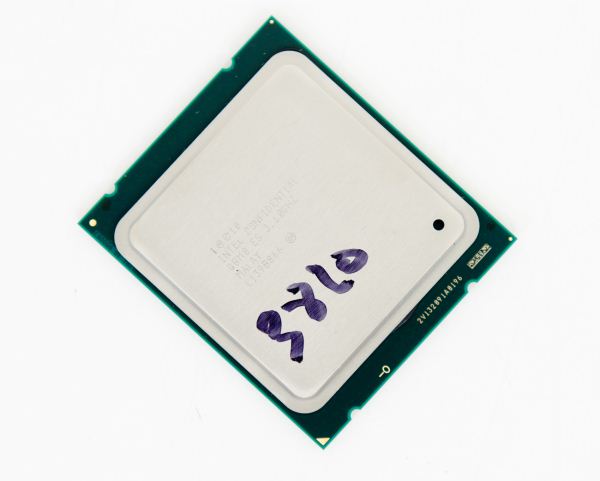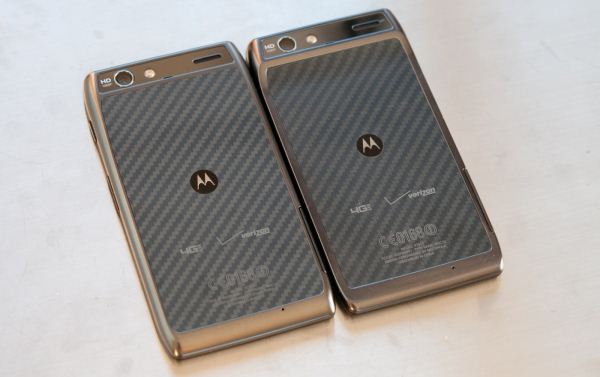Results 1,571 to 1,580 of 12091
Thread: Anandtech News
-
02-09-12, 10:30 PM #1571
Anandtech: OCZ Octane 1.13 Firmware Update: Improving 4KB Random Write Performance
The one thing that OCZ has been missing for so many years is finally one of its staples: focus. The same company that dabbled in everything from brain mice to DIY notebooks is now almost exclusively an SSD company that peddles power supplies on the side. OCZ's penchant for aggressively trying new things hasn't faded away however. As an SSD maker, OCZ is currently or will in the near future, be shipping drives based on controllers from three different vendors - each with their own strengths. OCZ's relationship with SandForce continues and the Vertex 3 remains OCZ's highest performing offering. A recent partnership with Marvell gives OCZ early experience with native PCIe based SSDs, experience that is extremely important as the industry marches towards a new PCIe based interface standard for SSDs (SATA Express). Finally there's OCZ's own controller, the Indilinx Everest, which it is quickly building momentum behind. It's obviously in OCZ's best interests to have its own controllers in the bulk of the drives it makes, but one doesn't simply build a better controller than everyone else on the first try.
A few weeks ago OCZ released a firmware update for its Octane drives that promised a significant increase in 4KB random write performance. Read on for our analysis of the firmware update!
More...
-
02-10-12, 05:11 AM #1572
Anandtech: SilverStone Temjin TJ04-E: Devil in the Details
The overwhelming majority of cases from SilverStone we've reviewed so far have been based on some very unorthodox designs, featuring layouts that feel ATX in name only. Yet when we visited with them at CES and they showed off the Temjin TJ04-E, we were surprised: at least superficially, the TJ04-E looked like a garden variety ATX case. It had SilverStone's usual clean lines and style, but everything seemed almost too normal. Thankfully we have the Temjin TJ04-E in house today, and while it may indeed look fairly by-the-book at first glance, SilverStone's mad scientists have tweaked quite a few things beneath the surface.
More...
-
02-10-12, 05:10 PM #1573
Anandtech: Enermax Platimax 750W - 80 Plus Platinum Arrives
Since the introduction of the 80 Plus certifications, we've seen a slow but steady trickle down effect where labels that were once reserved for the highest of the high-end (e.g. 80 Plus Gold) have eventually reached mainstream price points. Manufacturers including FSP, Rosewill, Sparkle, and SuperFlower now sell affordable 80 Plus Gold power supplies for less than $100. But if mainstream users are now able to get 80 Plus Gold, what should the high-end market offer? Enter 80 Plus Platinum:
Those looking for maximum efficiency can now set their sights on 80 Plus Platinum PSUs, which will be new halo market for high-end--and high cost--power supplies. To reach the necessary efficiency levels, some improvements are necessary that can change some of the core characteristics of a power. Improved resonant topologies, new MOSFETs for synchronous rectifying, higher switching frequencies, better drivers, and low-resistance conduction paths are just some of the things we'll see with 80 Plus Platinum. We're naturally eager to see what the new models can bring to the table, and Enermax sent us their Platimax 750W model, which uses an optimized Modu87+ design. Read on to find out if Enermax is the new efficiency king, and how it performs in other metrics.
More...
-
02-13-12, 12:10 AM #1574
Anandtech: Sony Vaio Z2: Everything is Peripheral
Users who want everything out of their notebook, no matter how ridiculous the demands, are probably more than at least a little curious about Sony's VAIO Z2. There's good reason to be: this 13.1" ultrabook features a stunning 1080p screen, a secondary battery slice that nearly doubles running time off the mains, and an external dock box that features an optical drive, additional connectivity, and a dedicated GPU that can actually be used to power the notebook's internal screen.
The VAIO Z2 has a lot going for it, but is it worth the heavy price tag? Outside of the specs on paper—which admittedly look quite good—what's the build quality like on the Z2, how does it fare in day to day use, and are there any concerns or benefits that might not immediately stand out? We'll cover that and more as we put this laptop to the test.
More...
-
02-13-12, 08:10 AM #1575
Anandtech: TI Announces WiLink 8 Family - WiFi, GNSS, NFC, BT, and FM Combo Chip
It goes without saying that connectivity is a hugely important part of smartphones. After all, without some sort of network connection, you've basically just got an expensive PDA or PMP. Today, TI is making formal the WiLink 8 family, the newest member of its popular WiLink series of WLAN combo chips, which is built on a 45nm process. WiLink 8 adds support for GNSS (Global Navigation Satellite System - GPS + GLONASS) and NFC in addition to WiFi, Bluetooth, and FM receive/transmit like we've seen in WiLink 7 in a number of devices.
The WiLink 8 family includes 15 different discrete solution options, and TI has provided a feature comparison for those parts. The configuration options basically afford OEMs the ability to choose whether they want GNSS (which they might not if the baseband or SoC provides it), NFC (possibly for low-end devices), and a simplified WLAN-only option.
WiLink 8 WiFi support builds on WiLink 7 by also adding both 2.4 and 5 GHz radio support, and most interestingly the option to connect using either dual-band 2x2:2 MIMO with a 20 MHz WiFi channel, or single spatial stream (1x1:1) on 40 MHz wide channel. This is an interesting and unique feature that we haven't seen before from the other combo chip players, and I'm eager to see if OEMs opt to go for the 2x2:2 solution. Tablets are probably the most logical place for 2x2:2 considering that a larger device means better chances of getting two decently uncorrelated streams. The WiLink 8 series also includes an integrated NFC controller with support for all of the NFC forum use cases and modes, and TI tells us they've already partnered with a number of Secure Element (SE) providers (TI names Infineon and NXP in its release) as well for support.TI WiLink 8 Series Comparison Technology Option WL189x solutions WL187x solutions WL185x solutions WL183x solutions WL180x solutions Dual-band 2x2 MIMO WL1897 WL1877 WL1857 WL1837 WL1807 Wi-Fi 802.11 a/b/g/n WL1893 WL1873 WL1853 WL1833 WL1803 Wi-Fi 802.11 b/g/n WL1891 WL1871 WL1851 WL1831 WL1801 Wi-Fi SS 40MHz (HT40) Y Y Y Y Y GNSS Y Y Bluetooth technology Y Y Y Y Bluetooth low energy Y Y Y Y ANT+ Y Y Y Y NFC Y Y FM Rx/Tx Y Y Y Y
Integrated GNSS support is also very interesting, as for a while now Qualcomm has been the only player I've seen offering smartphone-tailored GNSS receiver with support for GPS and Russia's GLONASS constellation in newer SoCs and basebands. TI tells me they also have a different approach to managing use and prioritization of GPS/GLONASS than Qualcomm, whose solution right now only uses GLONASS when GPS SNR is low. We'll see products with WiLink 8 inside in the second half of 2012.
Source: Texas Instruments
More...
-
02-13-12, 03:10 PM #1576
Anandtech: VLC 2.0 Announced: New UI and Blu-Ray Support for OS X
VideoLAN has announced VLC 2.0 and the first release candidate is available to the public today. The biggest changes are in the OS X version but there are a few interesting changes in the Windows version as well, such as a 64-bit version and support for multiple video files inside RAR archives. The OS X version will remain 32-bit but has a totally new user interface (see pictures below) along with Blu-Ray playback support.
Lets talk briefly about Blu-Ray playback in OS X. Apple does not officially support Blu-Ray as they provide no option for Blu-Ray drives and the software support is poor to say the least. Blu-Ray discs are encrypted so not just any player can play them. Since Apple doesn't support Blu-Ray, there hasn't been a player that would enable one-click Blu-Ray playback. However, it's still been possible to rip and encode the video with the OS X version of MakeMKV, in which case the video will become a regular MKV file that is supported by various players. There is also a direct playback method but it's rather complicated and doesn't work with all discs. VideoLAN is promising that VLC 2.0 will sport experimental Blu-Ray playback support, but unfortunately we don't know yet how functional it is. Another big improvement in the OS X version is support for Lua-based extensions. There are at least a dozen different extensions but the most notable are probably subtitle finder and movie information.
The Windows version isn't getting any major new features; it's mainly under the hood changes but it already supports the features that are new in the OS X version. VideoLAN is apparently also working hard on porting VLC 2.0 for iOS, which is a bit of surprise given that the original VLC app was pulled from the App Store about a year ago.
The first release candidate can be downloaded here and the complete change log is available here.
More...
-
02-13-12, 11:20 PM #1577
Anandtech: Samsung Refreshes Galaxy Tab Again: Dual-Core, No Plus
The original 7" Galaxy Tab was already long in the tooth when it was refreshed in the form of the Galaxy Tab 7.0 Plus. That iteration brought Samsung's mighty Exynos SoC to bear on an otherwise meager tablet. Great isn't apparently good enough, though. Samsung's seen fit to produce a true successor, the awkwardly named Galaxy Tab 2 (7.0).
So what's different this time? The Tab Plus already padded out the length and width of the original, while slimming down the depth; the Tab 2 is just a little thicker this time around. The 7" screen remains a PLS panel with a 1024x600 resolution, nothing too astonishing. The SoC is based on a dual-core design clocked at 1 GHz even. We haven't previously seen an Exynos SoC clocked at 1 GHz, though it's not inconceivable. Qualcomm has some dual-core parts clocked the same, as does NVIDIA.
The only other notable feature of the Tab 2 (7.0) is that it will be the first Samsung-branded device running Ice Cream Sandwich (Android 4.0). Hewing to their old habits, Samsung has seen fit to bring TouchWiz to the ICS experience, and from the looks of things we shouldn't expect anything to groundbreaking. The usual assortment of Hubs will be on order (Music, Media, Social and Game), along with a new app curation tool S Suggest (kind of like an App Hub). They're also including a Motocast competitor called AllShare Play. Like Motorola's entrant, the AllShare Play app allows users to view media stored on their PCs or other Samsung devices from wherever they have an internet connection.
The presence of Android 4.0 might point us to another likely suspect for SoC: TI. Samsung's involvement in the Galaxy Nexus is no secret, and they have had the most time with the ICS code as any manufacturer. It's plausible that in order to expedite shipping their first ICS tablet, Samsung chose the Nexus' platform, TI's OMAP 44x0. If that's the case, GPU performance could take a hit versus the Galaxy Tab 7.0 Plus, particularly when that device gets updated to ICS.
Pricing and availability Stateside have yet to be announced; though UK availability is pegged for March. In just two short years, Samsung has gone from having no tablets to a stable at least six deep (more if you count the 10.1v and 10.1N). The Galaxy Tab 2 (7.0) may fall short in the hardware department, especially compared to something like the Transformer Prime, but the 7" form factor has long been a fan favorite, and at the right price this could be a great way to experience Ice Cream Sandwich on a tablet. We'll update when we have pricing and availability.
Gallery: Samsung Refreshes Galaxy Tab Again: Dual-Core, No Plus Product Image (2)_thumb.jpg)
 Product Image (3)_thumb.jpg)
 Product Image (4)_thumb.jpg)
More...
-
02-14-12, 12:40 PM #1578
Anandtech: AMD's Eric Demers is Leaving the Company
I just found out that AMD's Eric Demers (Corporate VP & CTO, Graphics Division) is leaving the company at the end of this week. He's not going to Intel or NVIDIA but I suspect that someone of Eric's talents will remain in the industry. I just had dinner with Eric a couple of weeks ago and he seemed very positive on AMD's roadmap going forward. Given how important the GPU is becoming in this ever expanding industry, someone like Eric is in very high demand.
We now have an official statement from AMD:
Eric Demers, AMD Corporate Vice President and CTO, Graphics Business Unit, has decided leave AMD to pursue other opportunities.
AMD Chief Technology Officer Mark Papermaster will assume interim responsibility for the Graphics Business Unit CTO role until a replacement is found.
AMD remains fully committed to our critical graphics IP development and discrete GPU products. We have a tremendous depth of talent in our organization, a game plan that is resonating with our customers and our team, and we are continuing to bring graphics-performance-leading products to market. We will attract the right technology leader for this role.
We thank Eric for his contributions to the business and wish him well in his future endeavors.
More...
-
02-14-12, 01:10 PM #1579
Anandtech: Intel Releases Core i7-3820
Intel has finally filled out the Sandy Bridge E lineup by releasing the Core i7-3820. The initial Sandy Bridge E lineup launched back in November 2011 and it consisted of two SKUs, the i7-3960X and i7-3930K. While the i7-3820 wasn't released until this week, we reviewed it over a month ago, so head there for a longer analysis. The table below summarizes the current Sandy Bridge E lineup:
The short summary is that i7-3820 is Sandy Bridge E on a budget. In terms of CPU performance and price, it's equivalent to the i7-2600(K) but provides higher I/O performance due to the quad-channel memory and 40 PCIe 3.0 lanes. Anand summed it up nicely in his review, so we'll just repost here.Processor Core Clock Cores / Threads L3 Cache Max Turbo Max Overclock Multiplier TDP Price Intel Core i7 3960X 3.3GHz 6 / 12 15MB 3.9GHz 57x 130W $999 Intel Core i7 3930K 3.2GHz 6 / 12 12MB 3.8GHz 57x 130W $583 Intel Core i7 3820 3.6GHz 4 / 8 10MB 3.9GHz 45x 130W $294
There are three reasons why you'd want the Core i7-3820:
- You need PCIe 3.0 today and/or you need more PCIe lanes than a Core i7-2600K can provide.
- You need tons of memory bandwidth for a particular application.
- You want a 2600K but you need a platform that can support more memory (32GB+).
So in general, most users will be better off with a LGA 1155 based platform. While the i7-3820 is actually cheaper than the i7-2600K, the total price of the platform is not. LGA 1155 based motherboards go for as little as ~$50 (e.g. Gigabyte GA-H61M-DS2). If you want more features such as Intel Rapid Storage Technology, you can get a Z68 based motherboard for around $90 (e.g. ASRock Z68M/USB3). In contrast, the cheapest LGA 2011 based motherboard starts at $210. Unless you benefit from the extra features that Sandy Bridge E offers, your money is better spent else (e.g. on an SSD).
More...
-
02-14-12, 01:10 PM #1580
Anandtech: Motorola Droid RAZR MAXX Review - 1.8x The Battery
For a while now, our chief complaint when talking about 4G LTE handsets has been battery life. The combination of 45nm cellular basebands, ever increasing screen size, and 4x nm SoCs has been unforgiving in the power department. Handset manufacturers are always engaged in a difficult balancing act between device size, price, and the resulting battery life. Too big of a battery and you’ve created a brick that looks unattractive next to other svelte phones, too small and you’ve created something that looks great but needs to be tethered to the wall all day.
The Droid RAZR MAXX is quite simply a Droid RAZR with a larger internal battery, 1.8 times the size of the original, to be exact. The result is a device that does internal batteries the right way - if it's going to be sealed inside, it should at least be huge. Read on for our full RAZR MAXX review.
More...
Thread Information
Users Browsing this Thread
There are currently 15 users browsing this thread. (0 members and 15 guests)






 Quote
Quote





 Product Image (1)_575px.jpg)



















Bookmarks